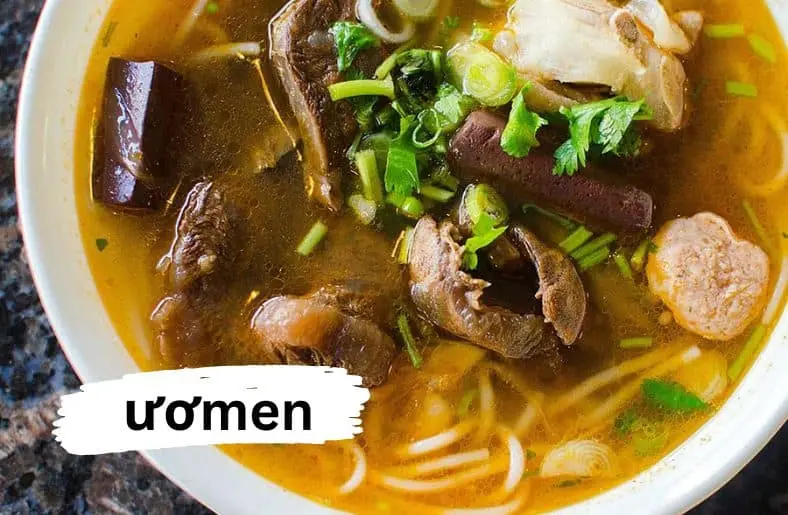Introduction of ươmen
Prepare to embark on a flavorful journey into the heart of Vietnam’s culinary heritage with “Ươmen Unveiled | Vietnamese Culinary Delight.” This blog post uncovers the secrets of a beloved dish that has captured the hearts and taste buds of millions worldwide. Discover the rich history, vibrant ingredients, and cultural significance of Ươmen. As we delve into its origins and preparation methods, you’ll gain insights into the diverse variations across different regions. Explore the deep-rooted symbolism and traditions associated with this culinary gem, understanding its role beyond just a meal. From its health benefits to global popularity, Ươmen continues to make waves in modern gastronomy. Learn valuable cooking tips and recipes to savor the authentic flavors of Ươmen in your own kitchen. Join us in celebrating the essence of Vietnamese cuisine through this captivating exploration of Ươmen.
Origins and History of Ươmen
Ươmen, a beloved Vietnamese dish, traces its origins to the bustling streets of Hanoi. In the early 20th century, it emerged as a humble street food known as “phở bát đặc biệt.” Over time, it evolved into the iconic dish we know today as Ươmen.
Legend has it that Ươmen originated within the royal kitchens of the Nguyễn Dynasty in Huế. Royal chefs crafted a fragrant broth infused with spices like cinnamon and star anise, creating the foundation of Ươmen’s distinctive flavor profile.
As Ươmen gained popularity, it transcended social boundaries and became a staple in Vietnamese cuisine. Its journey from royal palaces to street corners reflects Vietnam’s rich culinary heritage and the fusion of royal sophistication with street food simplicity.
The name “Ươmen” itself is a blend of “ướp” (marinate) and “mì” (noodles), highlighting the dish’s marinated meats and soft noodle components. This name change signified Ươmen’s evolution into a culinary masterpiece with its own identity.
Despite regional variations in ingredients and preparation methods, the essence of Ươmen remains consistent—a harmonious blend of savory broth, delicate noodles, and flavorful toppings. This consistency across generations and regions underscores Ươmen’s enduring appeal and cultural significance.
Today, Ươmen stands as a symbol of Vietnam’s culinary prowess, offering a sensory journey into the country’s vibrant food culture. Its rich history and diverse flavors continue to captivate food enthusiasts worldwide, making it a timeless delight on dining tables and street corners alike.
Ingredients and Preparation
To create the delectable Ươmen, several key ingredients and meticulous steps are essential. The process begins with high-quality beef or chicken bones, simmered for hours to extract their rich flavors. Fragrant herbs like star anise, cinnamon, and cloves are added to the broth, infusing it with aromatic goodness.
Next comes the rice noodles, a staple component of Ươmen. These soft noodles are cooked separately and then added to the broth just before serving, ensuring they maintain their texture and soak up the flavorful broth.
For the meat component, thinly sliced beef or chicken is marinated in a mixture of fish sauce, sugar, and spices. This marinade not only tenderizes the meat but also adds layers of savory depth to each bite.
Once all the elements are ready, it’s time for assembly. The cooked noodles are placed in a bowl, topped with the marinated meat, and then covered with the steaming hot broth. This process allows the flavors to meld together, creating a harmonious blend of tastes and textures.
Finally, the dish is garnished with an array of fresh ingredients such as bean sprouts, cilantro, lime wedges, and chili peppers. These garnishes not only add visual appeal but also provide bursts of freshness, crunch, and spice to each spoonful.
The careful selection of ingredients and precise preparation methods are what make Ươmen a culinary masterpiece. Each step contributes to the dish’s overall balance of flavors and textures, ensuring a delightful dining experience that delights both young and old alike.
Variations Across Regions
The beauty of Ươmen lies in its versatility across different regions of Vietnam. Each area puts its unique spin on this beloved dish, creating variations that reflect local tastes and ingredients.
In the northern region, particularly in Hanoi, Ươmen is known for its clear and delicate broth, highlighting the natural flavors of the beef or chicken. The noodles are typically thin and soft, allowing them to absorb the essence of the broth.
Moving to central Vietnam, the Ươmen takes on a spicier profile. Here, chilies are added generously to the broth, infusing it with a fiery kick that contrasts beautifully with the richness of the meat and noodles. Coconut milk is sometimes used to add a creamy texture to the broth, creating a unique flavor experience.
In the southern part of the country, it’s embraces the sweetness of coconut. The broth is often made with coconut milk, giving it a luscious and creamy consistency. This version of it is less spicy but incredibly flavorful, with a hint of sweetness that complements the savory elements.
Beyond Vietnam, variations of Ươmen can also be found in neighboring countries like Cambodia and Thailand. While the basic elements remain the same, local ingredients and cooking techniques add distinctive nuances to the dish, making it a delightful exploration of flavors across borders.
Whether you prefer the clear simplicity of the northern style, the spicy kick of central Vietnam, or the creamy richness of the southern version, Ươmen offers a culinary journey that celebrates diversity and creativity in Vietnamese cuisine.
Cultural Significance and Symbolism
Ươmen goes beyond being just a dish; it holds deep cultural significance and symbolism in Vietnamese traditions.
At its core, Ươmen represents unity and family bonding. Families often gather around a steaming bowl of Ươmen, sharing stories and creating lasting memories. It’s a symbol of togetherness and the importance of communal meals in Vietnamese culture.
Moreover, Ươmen is tied to ancestral reverence. It’s common for Vietnamese households to offer Ươmen during ancestral ceremonies and festivals, honoring their ancestors and seeking blessings for prosperity and well-being.
The ingredients in Ươmen also carry symbolic meanings. The noodles symbolize longevity and good fortune, while the broth represents nourishment and comfort. The use of fresh herbs and vegetables signifies vitality and the bounty of nature.
In Vietnamese folklore, Ươmen is often associated with tales of resilience and ingenuity. Stories of how Ươmen sustained soldiers during wartime or nourished communities in challenging times highlight its role as a symbol of strength and survival.
Beyond its cultural symbolism, Ươmen also reflects Vietnamese values of resourcefulness and adaptability. Its ability to evolve and incorporate diverse flavors and ingredients speaks to the resilience of Vietnamese cuisine and its ability to embrace change while staying rooted in tradition.
Overall, Ươmen is not just a meal; it’s a cultural emblem that embodies the rich heritage, values, and spirit of the Vietnamese people.
Health Benefits and Nutritional Value
Ươmen offers more than just delicious flavors; it also comes with numerous health benefits and a high nutritional value.
Firstly, Ươmen is a great source of protein, essential for muscle growth and repair. The meat or tofu in Ươmen provides this protein boost.
Additionally, Ươmen contains carbohydrates from the noodles, offering a quick energy source for daily activities.
The broth in Ươmen is often infused with herbs and spices, providing antioxidants that support a healthy immune system and fight inflammation.
Furthermore, Ươmen is low in fat, especially when prepared with lean meats or plant-based proteins, making it a heart-healthy option.
The vegetables and herbs in Ươmen contribute vitamins and minerals, such as vitamin C from lime and antioxidants from cilantro and basil.
For those watching their calorie intake, Ươmen can be customized to fit a lower-calorie diet by reducing oil and using lighter broths.
Overall, Ươmen strikes a balance between taste and nutrition, offering a satisfying meal packed with essential nutrients for overall well-being.
Global Influence and Popularity
Ươmen’s popularity has transcended borders, making it a global culinary sensation.
Initially a local delicacy in Vietnam, Ươmen has gained international recognition, especially in Asian communities.
Its unique blend of flavors and customizable ingredients has led to its widespread adoption in restaurants worldwide.
In Western countries, Ươmen is often enjoyed as a trendy street food or a comforting bowl in upscale eateries.
The versatility of Ươmen has also led to fusion dishes, blending Vietnamese flavors with local cuisines.
Tourists visiting Vietnam often seek out authentic it’s experiences, contributing to its cultural exchange and appreciation.
Online platforms and food bloggers have further amplified Ươmen’s fame, showcasing its diversity and culinary creativity.
Overall, Ươmen’s global influence highlights its enduring appeal and status as a beloved dish across continents.
Ươmen in Modern Times
In today’s culinary landscape, Ươmen continues to captivate food enthusiasts worldwide.
Restaurants globally offer creative spins on traditional it, catering to diverse palates and preferences.
Modern chefs experiment with innovative toppings and presentation styles, keeping it relevant and exciting.
Food delivery services and ready-to-cook meal kits have made it accessible to busy households, ensuring its place in contemporary diets.
Social media platforms showcase stunning visuals and recipes, fueling Ươmen’s popularity among the digital generation.
Health-conscious consumers appreciate it’s nutritious ingredients and balanced flavors, aligning with modern wellness trends.
As a timeless comfort food with a touch of nostalgia, it bridges generations and cultures, embodying the essence of culinary evolution.
Cooking Tips and Recipes
Creating a perfect bowl of Ươmen at home is easier than you think.
Start by preparing your broth with fresh herbs and spices for authentic flavor.
Choose your protein—chicken, beef, or tofu—and cook it to tender perfection.
Soak rice noodles until they’re soft and ready to absorb the savory broth.
Add a variety of fresh vegetables like bean sprouts, cilantro, and sliced chilies for a burst of color and freshness.
Customize your bowl with condiments like lime wedges, hoisin sauce, and chili oil for added depth of flavor.
Garnish with a sprinkle of chopped green onions and a dash of fish sauce for the final touch.
Follow these simple steps, and you’ll have a steaming bowl of homemade Ươmen that rivals any restaurant version.
Conclusion
In conclusion, “Ươmen Unveiled | Vietnamese Culinary Delight” takes us on a captivating journey through the heart of Vietnam’s culinary heritage. From its humble origins to global popularity, Ươmen has evolved into a cultural emblem that symbolizes unity, resilience, and culinary creativity. Through exploring its rich history, diverse variations, health benefits, and global influence, we gain a deeper appreciation for this beloved dish. Whether enjoyed in traditional settings or modern interpretations, it’s continues to delight taste buds and bring people together, embodying the timeless essence of Vietnamese cuisine and culinary innovation. Join the celebration of it and savor its flavorful legacy.





